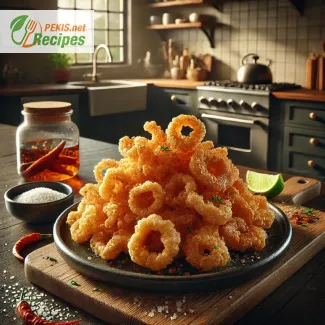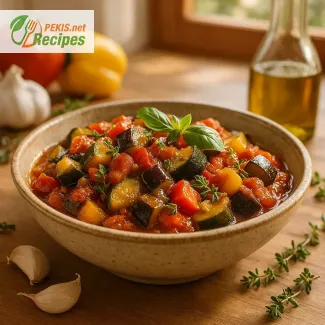
The Crispy Delight of Chicharon: A Timeless Culinary Treasure
A Crunchy Bite into Tradition
Few snacks can rival the irresistible crunch and savory indulgence of chicharon. This beloved dish, originating from Spanish and Filipino culinary traditions, has won hearts across the world with its golden, crispy texture and deeply satisfying flavor. Whether served as a snack, an appetizer, or a crunchy topping, chicharon remains a staple in many cultures, offering both nostalgia and unforgettable taste.
Chicharon is essentially fried pork rinds, cooked to perfection until they achieve that light, airy crispness that makes every bite irresistible. But this delicacy isn’t just about texture; it’s about the bold, savory richness that lingers on the palate. Paired with a zesty vinegar dip, spicy chili, or even a tangy sauce, this dish delivers a contrast of flavors that keeps food lovers coming back for more.
The Perfect Balance of Flavor and Texture
The magic of chicharon lies in its perfect balance between crispness and rich, meaty flavor. Each piece is rendered, fried, and puffed to create that unmistakable crunch, which is then enhanced by just the right amount of salt and seasoning. The result? A deeply satisfying snack that can be enjoyed on its own or incorporated into various dishes for added texture and depth.
The preparation of chicharon varies depending on regional influences. Some versions are light and airy, while others are thicker with a more substantial crunch. Regardless of the style, one thing remains constant—its addictive nature. Once you start eating, it’s hard to stop!
A Snack with History and Cultural Significance
Chicharon’s origins can be traced back to Spanish cuisine, where pork rinds were fried as a way to utilize every part of the pig. Over time, this technique spread to Latin America, the Philippines, and other parts of the world, evolving into different variations. In the Philippines, chicharon is a beloved street food often sold in small plastic bags, ready to be enjoyed on the go. In Mexico, it’s used in tacos or topped with lime and chili for a bold, spicy twist. Meanwhile, in Spain, chicharrones are often served as a tapa, paired with a cold drink.
Beyond its role as a snack, chicharon has also found its way into various traditional dishes. It’s commonly used as a topping for soups, stews, and noodle dishes, adding a crunchy contrast to softer textures. Some even enjoy it as a side dish to balance out rich, meaty flavors.
The Irresistible Pairings of Chicharon
One of the reasons chicharon remains so popular is its versatility. While delicious on its own, this crispy treat can be elevated with various dips and accompaniments.
- Spiced vinegar – The most classic pairing, the acidity cuts through the richness and enhances the flavor.
- Salsa and guacamole – A popular choice in Latin America, adding freshness and depth.
- Chili and lime – For those who enjoy a spicy kick with a citrusy twist.
- Melted cheese dip – An indulgent option that adds a creamy contrast.
- Soups and stews – Used as a garnish, chicharon can bring crunch and flavor to broths.
The Ultimate Comfort Food
Chicharon is more than just a snack; it’s a comfort food that brings people together. Whether it’s enjoyed during a family gathering, a celebration, or a simple afternoon snack, its crunchy goodness always delivers a moment of pure satisfaction. It’s a reminder of simple yet indulgent pleasures, offering a taste of both tradition and innovation.
With its rich history, satisfying texture, and irresistible flavor, chicharon continues to be a beloved treat worldwide. Whether you enjoy it as a standalone snack, a side dish, or an ingredient in a flavorful recipe, this crispy delight will never go out of style.
- Prepare the Pork Skin: Rinse the pork skin thoroughly under cold water. Remove any excess fat to ensure a crispy texture. Cut into strips or small squares, depending on your preference.
- Boil the Skin: In a large pot, bring 2 liters of water to a boil. Add the pork skin, salt, and vinegar. Simmer for about 1.5 hours or until the skin becomes tender.
- Dry the Skin: Drain the pork skin and lay it out on a tray. Pat dry with paper towels and let it air dry for at least 6 hours or overnight for best results. The drier the skin, the crispier the chicharon.
- Seasoning: Sprinkle garlic powder and black pepper evenly over the dried pork skin.
- First Frying: Heat oil in a deep pan to 160°C (320°F). Fry the pork skin in batches for about 2-3 minutes until it turns golden but not fully crisp. Remove and drain on paper towels.
- Cool and Rest: Let the fried pork skin rest for at least 30 minutes.
- Second Frying: Heat oil to 190°C (375°F) and refry the pork skin in batches for about 1-2 minutes until it puffs up and turns crispy. Remove and drain excess oil.
- Serving: Serve hot with spiced vinegar or your preferred dipping sauce.
Elevating Chicharon: Ways to Enhance This Classic Recipe
Choosing the Best Ingredients for a Superior Crunch
The quality of pork skin is one of the most crucial elements when preparing chicharon. Opting for fresh, high-quality pork skin with a balanced fat-to-skin ratio ensures the final product is both crispy and flavorful. Ideally, free-range pork yields a more intense depth of flavor and a firmer texture, which contributes to a satisfying crunch after frying.
Should You Remove the Fat?
Many traditional chicharon recipes suggest removing excess fat before frying. However, leaving a thin layer of fat enhances both flavor and texture. The fat renders down during cooking, infusing the skin with richness while keeping it light and crispy. Too much fat, however, can result in chewy and greasy chicharon, so trimming is essential.
Mastering the Drying Process for a Perfect Texture
One of the most overlooked yet critical steps in making chicharon is the drying process. Proper drying ensures that the skin puffs up perfectly when fried.
- Air-drying overnight allows for natural dehydration, producing a lighter, airier texture.
- Using a food dehydrator speeds up the process and ensures uniform drying, preventing unwanted chewy spots.
- Oven-drying at low heat (around 70°C or 160°F) for 3-4 hours achieves a similar effect, ensuring maximum crispiness once fried.
Experimenting with Seasonings and Marinades
While traditional chicharon is simply seasoned with salt and pepper, adding depth to the flavor profile can elevate the dish to new heights.
Infusing the Skin with Flavor Before Frying
- Garlic and Vinegar Soak – Soaking the pork skin in a vinegar and garlic mixture before drying enhances its tangy and savory notes, complementing its richness.
- Citrus Marinade – Marinating in lime or calamansi juice adds a refreshing, zesty contrast to the crispiness.
- Spiced Dry Rubs – Adding smoked paprika, cayenne, or cumin before frying introduces complex layers of flavor, making each bite more intriguing.
Post-Frying Seasonings for an Extra Flavor Boost
- Truffle Salt or Parmesan – Elevates the snack into a gourmet treat.
- Chili Powder and Lime Zest – Adds heat and brightness, perfect for those who enjoy a little kick.
- Herb-Infused Oils – Drizzling a light coat of rosemary or thyme-infused oil over the freshly fried chicharon enhances its aromatic appeal.
Perfecting the Double-Fry Method for Ultimate Crispiness
A single fry can create a decently crispy texture, but the double-fry method ensures a flawless crunch that lasts longer.
- First Fry (Low Temperature) – Frying the pork skin at 160°C (320°F) for a few minutes allows it to cook evenly without browning too quickly.
- Cooling Period – Letting the pieces rest for at least 30 minutes allows excess moisture to escape, improving the second frying process.
- Second Fry (High Temperature) – The final fry at 190°C (375°F) makes the chicharon puff up instantly, creating that light, airy texture.
The Benefits of Making Chicharon at Home
Control Over Ingredients and Quality
Store-bought chicharon often contains preservatives, excessive salt, and artificial flavorings. When making it at home, you have full control over ingredients, ensuring a fresher, healthier, and more authentic result.
Adjusting Oil for a Healthier Fry
Using high-quality oils such as avocado oil, coconut oil, or lard from pastured pork can improve both flavor and health benefits. Unlike commercial versions that use low-grade vegetable oils, these healthier options provide better fat balance and a cleaner taste.
Common Mistakes to Avoid
Skipping the Drying Step
Many home cooks rush the drying process, resulting in chewy and tough chicharon instead of crispy perfection. Always allow enough time for the skin to dehydrate properly.
Frying at the Wrong Temperature
If the oil is too cold, the skin will absorb excess oil, making it greasy. If the oil is too hot, the outside will brown too quickly while the inside remains undercooked. Maintaining the right temperature control is key.
Overcrowding the Pan
Frying too many pieces at once lowers the oil’s temperature, preventing the skin from puffing up properly. Always fry in small batches for consistent crispiness.
Healthier Alternatives to Traditional Chicharon
While pork chicharon is undeniably delicious, there are lighter and healthier alternatives that retain the same crunchy satisfaction.
Chicken Chicharon
- Made from chicken skin, this alternative contains less saturated fat than pork.
- It has a delicate crispness and a lighter texture, making it easier to digest.
Mushroom Chicharon
- Thinly sliced mushrooms dehydrated and deep-fried mimic the crunch of pork skin.
- A great option for vegetarians while still offering an umami-packed, crispy bite.
Fish Skin Chicharon
- Popular in Asian cuisine, fish skin crisps up beautifully and delivers high omega-3 content.
- Works well with the same seasoning and dipping sauces as traditional chicharon.
Pairing Chicharon with the Perfect Dips and Sides
The right dipping sauce can transform chicharon from a simple snack into an explosive flavor experience.
Classic Vinegar Dip
A Filipino favorite, vinegar cut with garlic, chili, and onions balances the richness with a tangy sharpness.
Creamy Cheese Sauce
A modern take on chicharon, this dip adds a luxurious, indulgent element to the crispy snack.
Salsa Verde
A Mexican-inspired dip, blending tomatillos, cilantro, and lime juice, offering a fresh, slightly spicy contrast.
Improving the traditional chicharon recipe is all about precision, patience, and creativity. By selecting the best ingredients, mastering the drying process, experimenting with flavors, and refining frying techniques, you can elevate this classic snack into a gourmet experience. Whether you keep it authentic or explore healthier alternatives, the joy of crafting homemade chicharon ensures every bite is deliciously rewarding.
- Contains no gluten.
- No common allergens, but those with pork allergies should avoid this dish.
Ingredient Substitutions for Allergen-Free or Gluten-Free Options:
- This recipe is naturally gluten-free.
- If avoiding pork, try using chicken skin or plant-based alternatives like soy protein skins for a vegetarian version.
- Iron (2.5 mg): Supports oxygen transport in the blood.
- Zinc (3.2 mg): Strengthens the immune system.
- Vitamin B12 (1.1 µg): Essential for nerve function and red blood cell formation.
- Selenium (32 µg): Acts as an antioxidant and supports thyroid health.
- Collagen peptides: Beneficial for skin health and joint support.
- Selenium: Protects cells from oxidative stress.





